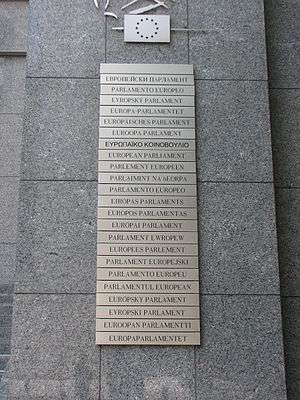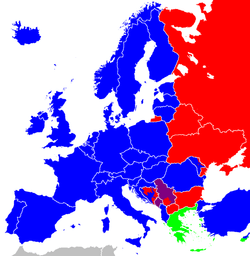Language of Europe
< Wikijunior:EuropeLanguages of Europe
Russian is the language spoken by the most people in Europe with native speakers found in Russia, Ukraine, Belarus, Kazakhstan, Armenia, Azerbaijan, Georgia, Estonia, Latvia and other parts of Europe.
The European Union has 24 official languages. Many Europeans speak 2 or 3 languages but the most common language to learn, by a long way, is English.

Most languages spoken in Europe are Indo-European languages which are languages which originated between Europe and India. The Indo-European languages in Europe can be divided into different groups:
- Albanian - spoken in Albania, Kosovo, and Macedonia
- Armenian - spoken in Armenia
- Baltic Languages - Lithuanian (in Lithuania) and Latvian (in Latvia)
- Celtic Languages - Welsh, Scottish Gaelic, Cornish and Manx, all spoken in the United Kingdom or countries which depend on the UK. Also Irish and Breton, spoken in Ireland and France.
- Germanic Languages - English (UK, Ireland and Malta), German (Germany, Austria and Switzerland), Dutch (Netherlands and Belgium), Danish (Denmark), Norwegian (Norway), Swedish (Sweden and Finland) and Icelandic (Iceland).
- Greek - spoken in Greece and Cyprus.
- Romance Languages - Catalan (Spain), French (France, Switzerland, Belgium), Italian (Italy and Slovenia), Portuguese (Portugal), Romanian (Romania and Moldova), Sardinian (Italy), Sicilian (Italy) and Spanish (Spain).
- Slavic Languages - Russian (Russia, Kazakhstan, Ukraine and Belarus), Ukrainian (Ukraine), Belarusian (Belarus), Czech (Czech Republic), Polish (Poland), Slovak (Slovakia), Bulgarian (Bulgaria), Macedonian (Macedonia), Slovene (Slovenia and Italy) and Serbian/Croatian/Montenegrin/Bosnian (Serbia, Croatia, Montenegro and Bosnia Herzegovina)
There are a few languages spoken in Europe which are not Indo-European languages:
- Kartvelian Languages - this group includes Georgian, spoken in Georgia.
- Uralic Languages - this group includes Estonian (Estonia), Finnish (Finland) and Hungarian (Hungary and Serbia)
- Turkic Languages - this group includes Turkish (Turkey and Cyprus), Azerbaijani (Azerbaijan) and Kazakh (Kazakhstan)
- Semitic Languages - this group includes Maltese (Malta)
All of the languages above - those in the Indo-European Language group or those from other groups are all related in some way to other languages. There is one language spoken in Europe which has no relation to any other language in the world:
- Basque - spoken in Spain and France.
You can read more about European languages and other world languages at Wikijunior Languages
Alphabets of Europe

- The Latin alphabet is used in most of Europe. Most EU countries use this alphabet. The first letters of the Latin alphabet are: A, B, C
- The Cyrillic alphabet is used in some parts of Eastern Europe and South Eastern Europe. At present, Bulgaria is the only EU country using this alphabet. Serbia, Montenegro and Bosnia are noteworthy because both Latin and Cyrillic alphabets are regularly used in those countries. The first letters of the Russian Cyrillic alphabet are: а, б, в
- The Greek alphabet is used in Greece and Cyprus. The first letters of the Greek alphabet are: Α, Β, Γ
- The Georgian alphabet is used in Georgia. The first letters of the Georgian alphabet are: ა, ბ, გ
| Wikijunior Europe • Intro • EU • Geo • People • Language • Facts • Quiz | |||
|
| |||